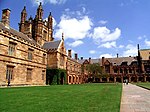|
Macleay Museum
The Macleay Museum at The University of Sydney, was a natural history museum located on the University's Camperdown campus, in Sydney, New South Wales, Australia. The museum was dissolved in 2016 and upon opening of the Chau Chak Wing Museum in 2020, its collections were amalgamated into it.[1] The Macleay Museum was added to the City of Sydney local government heritage list on 14 December 2012.[2][3] HistoryThe Edgeworth David building in which the museum was housed was built off Science Lane within the Camperdown campus in 1887. The collections were based largely on the efforts and acquisitions of the Macleay family, one of the pre-eminent families in colonial Sydney including Alexander Macleay, William Sharp Macleay and William John Macleay. The zoologist and collector George Masters served as curator until 1912.[4] CollectionThe strengths of the collection, now part of the Sydney University Museums, were in entomology, ethnography, scientific instruments, and historic photographs. Many of the biological specimens in the collection represented rare or extinct species, while some of the specimens have historic and cultural value[5] as they were collected by explorers like Charles Darwin and Nicholas Miklouho-Maclay. The George Masters Exhibition Space of the museum was devoted to temporary exhibitions. Overall, the museum housed one of the most important natural history and ethnography collections in Australia,[citation needed] surpassed in Sydney only by the Australian Museum. Gallery
See alsoReferences
External linksWikimedia Commons has media related to Macleay Museum. |
||||||||||||||||||||||||||||||||||||||||||||||||||





